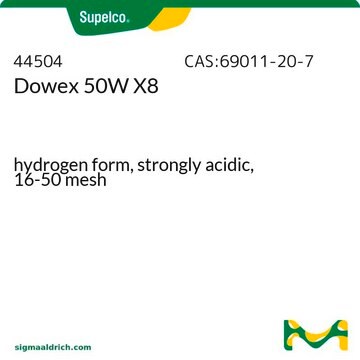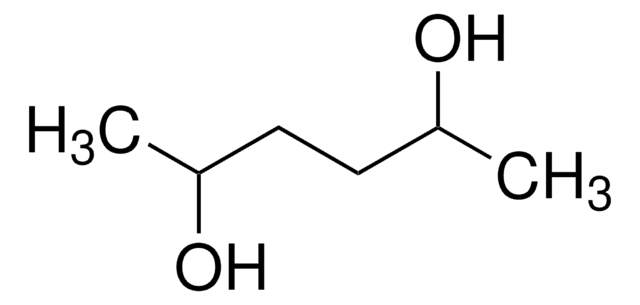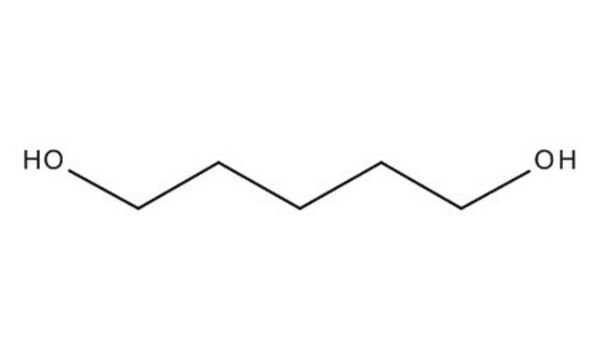240117
1,6-Hexanediol
99%
Sinônimo(s):
Hexamethylene glycol
Faça loginpara ver os preços organizacionais e de contrato
About This Item
Fórmula linear:
HO(CH2)6OH
Número CAS:
Peso molecular:
118.17
Beilstein:
1633461
Número CE:
Número MDL:
Código UNSPSC:
12162002
ID de substância PubChem:
NACRES:
NA.23
Produtos recomendados
pressão de vapor
0.53 mmHg ( 20 °C)
Nível de qualidade
Ensaio
99%
temperatura de autoignição
608 °F
Lim. expl.
16 %
p.e.
250 °C (lit.)
pf
38-42 °C (lit.)
cadeia de caracteres SMILES
OCCCCCCO
InChI
1S/C6H14O2/c7-5-3-1-2-4-6-8/h7-8H,1-6H2
chave InChI
XXMIOPMDWAUFGU-UHFFFAOYSA-N
Procurando produtos similares? Visita Guia de comparação de produtos
Descrição geral
1,6-hexanediol is a versatile chemical compound commonly used in the polymer industry. It is used as a building block or monomer for the synthesis of various polymers and polymer-based materials. For instance, it can be used in the production of polyesters, polyurethanes, and polyamides, among others. These polymers find applications in a wide range of industries, including automotive, textiles, coatings, adhesives, and sealants.
Aplicação
1,6-Hexanediol can be used for a variety of applications such as:
- a structure-directing agent for the synthesis of ZSM-5 zeolite
- a solvent for titanium tetra-isopropoxide to form titanium oxide (TiO2) nanocrystals
- a phase change material in combination with lauric acid for thermal energy storage applications
Código de classe de armazenamento
11 - Combustible Solids
Classe de risco de água (WGK)
WGK 1
Ponto de fulgor (°F)
215.6 °F - closed cup
Ponto de fulgor (°C)
102 °C - closed cup
Equipamento de proteção individual
Eyeshields, Gloves, type N95 (US)
Escolha uma das versões mais recentes:
Já possui este produto?
Encontre a documentação dos produtos que você adquiriu recentemente na biblioteca de documentos.
Os clientes também visualizaram
Microwave-driven polyol method for preparation of TiO2 nanocrystallites
Yamamoto T, et al.
Chemistry Letters (Jpn), 31(10), 964-965 (2002)
Guido van Mierlo et al.
Cell reports, 34(5), 108705-108705 (2021-02-04)
Membraneless organelles are liquid condensates, which form through liquid-liquid phase separation. Recent advances show that phase separation is essential for cellular homeostasis by regulating basic cellular processes, including transcription and signal transduction. The reported number of proteins with the capacity
Giorgio Gaglia et al.
Nature cell biology, 22(2), 151-158 (2020-02-06)
Under proteotoxic stress, some cells survive whereas others die. The mechanisms governing this heterogeneity in cell fate remain unknown. Here we report that condensation and phase transition of heat-shock factor 1 (HSF1), a transcriptional regulator of chaperones1,2, is integral to
H D Durham et al.
Muscle & nerve, 11(2), 160-165 (1988-02-01)
We reported previously that 2,5-hexanedione (2,5-HD), the neurotoxic metabolite of methyl-n-butylketone (MnBK) and n-hexane, induced aggregation of intermediate filaments of the vimentin type in cultured fibroblasts. To determine if these findings have relevance to the mechanism by which these hexacarbons
Sreejith J Nair et al.
Nature structural & molecular biology, 26(3), 193-203 (2019-03-06)
A crucial feature of differentiated cells is the rapid activation of enhancer-driven transcriptional programs in response to signals. The potential contributions of physicochemical properties of enhancer assembly in signaling events remain poorly understood. Here we report that in human breast
Nossa equipe de cientistas tem experiência em todas as áreas de pesquisa, incluindo Life Sciences, ciência de materiais, síntese química, cromatografia, química analítica e muitas outras.
Entre em contato com a assistência técnica











